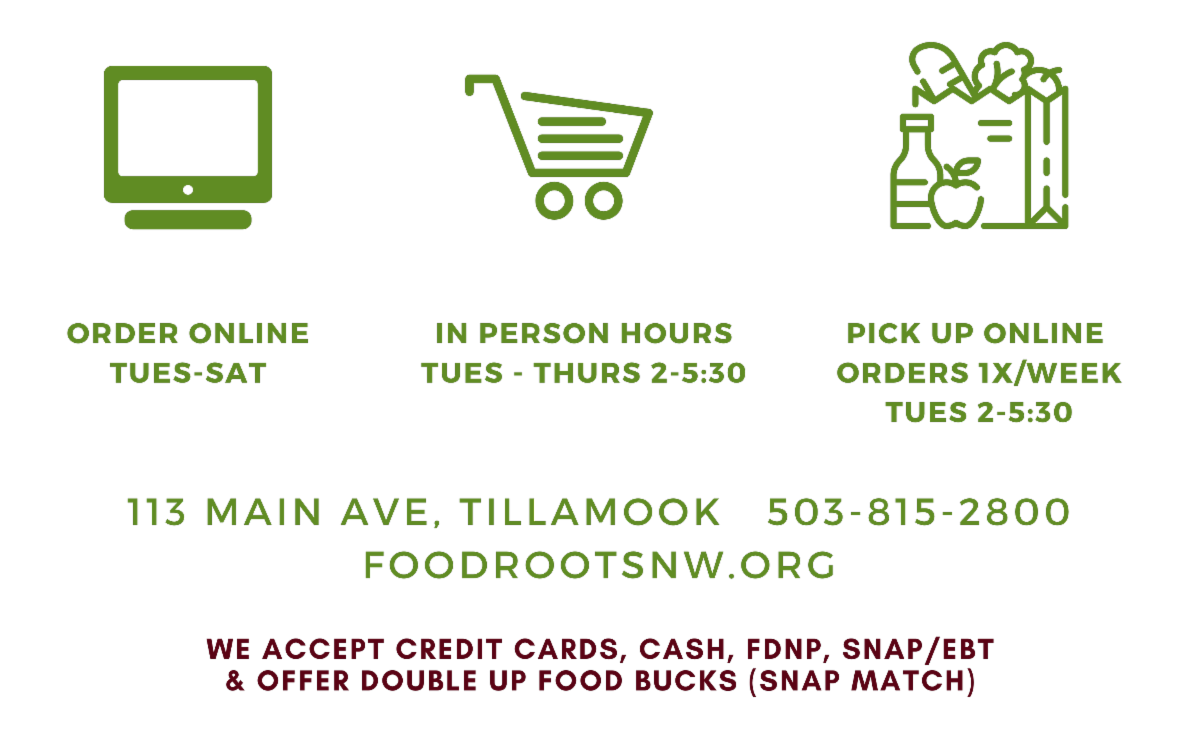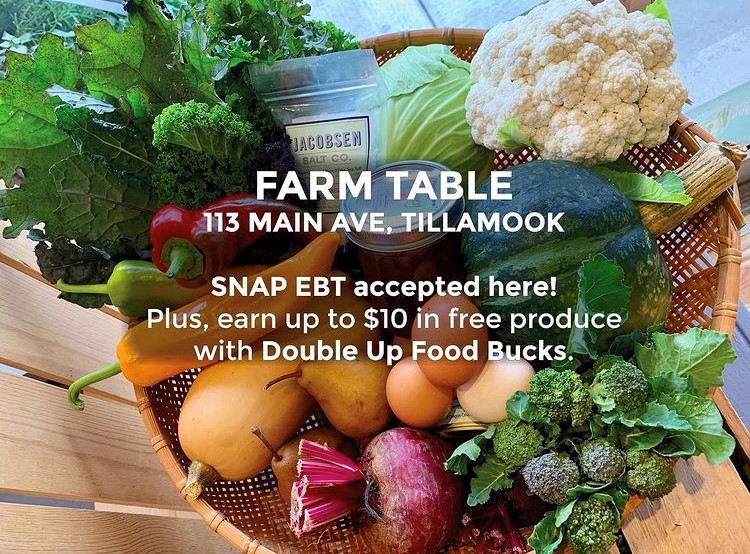
by Guest | Feb 23, 2021 | Being Well, Eat Well
March is National Nutrition Month and an easy way to focus on healthy eating is by choosing locally-sourced foods. Tillamook County residents have a variety of options when it comes to enjoying the bounty of local foods available literally from our own backyards. Gardening has seen a resurgence in popularity during the pandemic, and there are several sources for FREE seeds available at the main branch of the Tillamook Library. Call Sarah Beeler for more information about acquiring seeds at 503-842-4792 ext.1708. Food Roots will also be distributing seeds to EVERY kindergarten through 6th grader in Tillamook County.
If growing your own isn’t an option, consider signing up for a local CSA (Community-Support Agriculture) subscription box. This is a great deal and makes your veggie purchases easy throughout the growing season. Beginning in May or June depending on the farm, CSA subscribers receive a box (or set amount – half shares are often available) of seasonal produce. Generally, a full-share CSA provides enough, or usually more than enough, produce for a family of four, and often half shares are available as well. The CSA boxes also often come with recipes and ideas for the veggies, and include heirloom varieties and provide an opportunity to experiment and try lots of vegetables.
According to Corvus Landing Farm, “Your CSA share is truly an investment in the farm. Your early season payments have allowed us to buy seed, supplies, and invest in improvements to the farm. It is a huge motivator to know that there are folks ready and waiting to feast on the delicious returns! Thank you from the bottom of our hearts!”
For more information, contact the Farms directly for subscription information, amounts, costs, drop-off/pick-up/delivery and more:
Brickyard Farms
brickyard_farms@outlook.com
503-815-8142
Available “grown-at-the-coast” and tested for success in our Coastal environments – tomato and pepper starts available.
Watch for the list of tomato and pepper varieties – Email to be on the list to reserve your starts now – available mid-May.
Kingfisher Farms
503-888-3196 (Jeff Trenary)
20 weeks beginning in May
Moss Creek Family Farm
503-300-0085
Message on Facebook
Food Roots: 113 Main Ave Tillamook OR, 503-815-2800, https://www.foodrootsnw.org/
SNAP/EBT Payments for CSA Shares: Food Roots accepts SNAP payments for CSA Shares on behalf of their partnering farms. In addition, they provide SNAP customers with Double Up Food Bucks to reduce the overall cost of the CSA share, further increasing the affordability of local food. There are flexible purchasing options, please ask.
Register for your CSA Directly with Farms: Please note that this year registration for all CSA shares (including SNAP CSAs) will occur directly with farms. Please contact the farms above to choose and register for a share plan that works best for you. Some farms are in the process of setting up their CSA programs, so signup for their wait lists and be patient.
Farm Table Storefront: Meanwhile, until CSA’s begin, you can satisfy your appetite for local foods with Food Roots “Farm Table” storefront that features a wide variety of local producers including in-season vegetables, cheeses, eggs, honey and more! There are multiple ways to shop the Farm Table. You can order online here for pick up on Tuesdays between 2 and 5:30 pm. Or shop in person Tuesday, Wednesday or Thursday from 2 to 5:30 pm.
Pay it Forward with SNAP Match Donations: Food Roots offers a 2:1 match on SNAP dollars spent at FarmTable. This match can be used on all SNAP-eligible food items. Spend $1 with EBT payment, receive $2 free.
Interested in helping your neighbors purchase fresh food while supporting our region’s farmers and food producers? Just add “Support our SNAP Match Program!” to your cart with your next purchase. These funds are utilized as matching funds when customers shop with their EBT (food benefit) card.
New Delivery Service: Food Roots is gearing up for another launch this spring 2021, a new food delivery service available to FarmTable customers throughout Tillamook County and in partnership with North Coast Food Web of Clatsop County. Stay tuned for more details to come! The purchase of this new delivery vehicle was made possible thanks to Columbia Pacific Coordinated Care Organization, Tillamook County’s COVID-19 Relief Fund and Oregon Coast Visitors Association.
There are also local farm produce stands available with seasonal produce:
- Josi Farms (formerly DeNoble’s Produce Stand) at 735 Wilson River Loop, Tillamook – self-serve farm stand
- Valley Fresh Produce at 5112 Third St., Tillamook
- HomeGrown at Kendra’s River Inn, 34910 Hwy. 53 at Miami Foley Rd., Mohler
And, remember, starting in June local Farmers Markets will be opening as well – Manzanita Farmers Market on Fridays; Neskowin and Tillamook on Saturdays; and Pacific City on Sundays. Watch for more information about Farmers Market openings soon!
You can make every month “nutrition month” by eating locally-grown foods that provides so many benefits to mind, body, soul and community. When you buy from a local producer, you are not only feeding your family, you are helping to feed many local families.
AUTHOR: Laura Swanson, TCW Advisory Committee Member and Tillamook County Pioneer Editor
For more local health and wellness information, follow Tillamook County Wellness on Facebook, Instagram and Twitter.

by Guest | Feb 17, 2021 | Recipes
Number of servings: 6 cups
Time for preparation (including preparation & cooking): 1 hour
Ingredients
- 1 cup uncooked grain
- 2 cups vegetables, fresh, frozen or canned, cut bite-sized
- 1 cup cooked protein, cut bite-sized
- 2 1⁄2 cups Sauce
- 2 teaspoons seasonings (or more, to taste)
- 3 Tablespoons topping
Directions
To make in a skillet:
- Combine all ingredients except topping in a large skillet.
- Bring to a boil, stir occasionally, and then reduce heat to low. Cover and simmer until grains are tender, about 15 to 20 minutes, depending on the grain. Stir occasionally and add water if mixture becomes too dry.
- Add topping before serving.
- Refrigerate leftovers within 2 hours.
To bake in oven:
- Preheat oven to 350 degrees F.
- Combine all ingredients except topping in a casserole dish. Cover with a lid or aluminum foil and bake until grains are tender, about 45 minutes.
- Add topping before serving.
- Refrigerate leftovers within 2 hours.
Notes
Ingredient Ideas
- Grain – try quicker-cooking grains such as bulgur, macaroni, quinoa, white or quick brown rice
- Vegetables – try any mixture you have on hand
- Protein – try any type of beef, pork, chicken, turkey, seafood, tofu, beans
- Sauce – try one of these:
- Soup: 1 can (10.75 ounces) condensed soup and 1 1/4 cup water or milk
- Soy-ginger: 1 Tablespoon corn starch, 2 Tablespoons brown sugar, 1/4 cup soy sauce, 1 3/4 cup water or broth, 1 Tablespoon sesame oil (or vegetable oil)
- Broth: 2 Tablespoons flour (or 1 Tablespoon corn starch), 1 Tablespoon melted margarine or butter, 1/2 teaspoon salt and about 2 cups milk or broth to make 2 1/2 cups
- Tomato: 1 1/2 cups canned tomatoes with juice or tomato, enchilada or spaghetti sauce and water or stock to make 2 1/2 cups.
- Seasoning – try cumin, garlic powder, oregano, basil, cilantro, hot pepper sauce
- Topping – try grated cheese, nuts or seeds, crushed whole grain crackers
Recipe and Photo Source: https://foodhero.org/recipes/mix-and-match-skillet-meal

by Guest | Feb 17, 2021 | Recipes
Number of servings: 6 cups
Time for preparation (including preparation and cooking): 45 minutes
Ingredients
- 1 medium onion, chopped (about 1 cup)
- 1⁄4 cup celery, chopped
- 1 teaspoon oil
- 2 cups potatoes, peeled and diced bite size
- 2 cups chicken broth
- 1⁄4 teaspoon pepper
- 3 Tablespoons cornstarch
- 1 1⁄2 cups nonfat or 1% milk, divided
- 3⁄4 cup (3 ounces) cheddar cheese, shredded
- 1 Tablespoon bacon bits or 1 slice bacon, cooked and crumbled
Directions
- In a large saucepan over medium-high heat, sauté onions and celery in oil until onions are clear.
- Add the potatoes, broth, and pepper. Bring to a boil. Reduce heat; cover and simmer until the potatoes are tender, 15 to 25 minutes.
- In a small bowl, stir together cornstarch and ¼ cup of milk until smooth. Add remaining milk. Stir into the potato mixture.
- Cook and stir until thickened and heated through, about 5 minutes. Do not boil.
- Remove from heat. Stir in cheese until melted. Top with bacon bits. Serve warm.
- Refrigerate leftovers within 2 hours.
Recipe & Photo Source: https://www.foodhero.org/recipes/cheesy-potato-soup

by Guest | Feb 16, 2021 | Being Well
For those of you avoiding the frill and fancy of Valentine’s Day, here are some practical and indulgent recommendations this year from your friendly neighborhood therapist during this romance saturated holiday.
Key Concept: Choose yourself
Whether you’re single, coupled, or “it’s complicated” make sure you are prioritizing your own self-care. The following are ways we love ourselves including the fundamentals like staying well fed and hydrated. They also encourage focusing more on your goals and solo activities that promote wellness.
Physical Self-Care
The human body is performing just a few thousand automatic processes to keep you alive at any given moment. Even as you are reading this sentence, you’re using your eyes to read, brain to interpret, heart and lungs to breathe, all while presumably holding your bladder.
While keeping this machine running as an adult can sometimes seem like an Olympic sport, there are a few simple ways to maintain healthier living. Some of the basics are:
- Schedule and attend preventative medical appointments
- Be mindful of alcohol and substance use
- Get enough sleep (6-8 hours)
- Eat regularly
- Move your body as often as you can
Psychological Self-Care
Maintaining good mental and emotional health can often be deprioritized with the hustle and bustle of daily living. So much of our day consists of production-based thinking and for some, self-care might be considered a luxury or even selfish.
You likely have some small relief you find refuge in already and without these coping skills, burnout and compassion fatigue can creep up and surprise you. You might consider some of these additional recommendations helpful:
- Set boundaries to protect your self-care.
- Try using I statements “I feel (insert emotions here), when (insert situation here) happens”
- Recognize your own strengths and celebrate small victories
- Find the things that bring you comfort or make you laugh, then do that
- Remember unhealthy activities do not count as self-care like substance use or over-eating
Social Self-Care
In the last year, our social lives had a rough ride on the Corona-Coaster. Everyone’s “normal” changed. Some of us quarantined, most of us cancelled plans, and we’ve all learned to have conversations six feet apart. Maybe worst of all, seeing someone’s chin became an intimate act.
Whether you are craving the connection of others or you are enjoying the solitude, find what feels natural and supportive for you right now. Remember, everyone else is navigating all these weird changes together. You can also try:
- Check in with your own needs. Where are you on the spectrum of socializing today?
- Be honest with yourself about how you are balancing time together and apart.
- Find and practice your preferred method of communication and explain it to your loved ones. Examples: Video chat, phone calls, texts, e-mail, or taking some time off.
- Ask others for help when you need it.
- Follow up with people you haven’t heard from in a while.
Professional Self-Care
Whether you are clocking in, sending out applications, or staying at home. How are you doing with your professional goals? Don’t have any? Now may be a good time to reassess. What we do with our waking hours can help provide our lives with meaning and purpose.
Staying on track with your goals and staying motivated can be difficult when you feel overwhelmed or stagnate. These suggestions are meant to guide you through:
- Practice saying “no” to excessive new responsibilities
- Volunteer to work on projects that are interesting or rewarding
- Make time to talk and build relationships with colleagues
- Take the opportunity to learn additional skills in your field of interest
- Decompress during your breaks and lunch
Spiritual Self-Care
If you find meaning in promoting a cause, spiritual healing, or nurturing your faith, this section is for you. Slowing down to focus on your life’s purpose can restore fatigue and renew your perspective. Some good ways to reconnect to these principles are:
- Spend time in your place of healing. Examples: nature, house of worship, or demonstrations
- Participate in meditation and/or prayer
- Recognize the people, places, and things that give meaning to your life
- Set aside time for thought and reflection
- Appreciate art that is impactful to you. Examples: music, film, literature, dance
This information is based on materials provided by TherapistAid.com.
Consider meeting with a counselor or taking the Self-Care Assessment at https://www.therapistaid.com/worksheets/self-care-assessment.pdf and reviewing Self-Care Tips at https://www.therapistaid.com/worksheets/self-care-tips.pdf
AUTHOR: Karen Sheelar, Behavioral Health Clinician at Tillamook County Community Health Center
For more local health and wellness information, follow Tillamook County Wellness on Facebook, Instagram and Twitter.

by Guest | Feb 10, 2021 | Being Well, Eat Well
What does pleasant hunger feel like to you? This can be a hard question to answer! Pleasure and hunger don’t always seem to belong in the same sentence. Unpleasant hunger makes more sense. “Hanger” and the negative emotions associated with a feeling of “starvation” come to mind right away. Luckily, hunger can be pleasant if it is realized early on and leads to intentional planning of when and what you eat.
Pleasant hunger is thinking to yourself “I think I’m ready for a meal/snack” and allowing yourself to consider what’s available, sounds satisfying and meets your health goals. You sit down to eat and find yourself savoring your food. This is a pleasurable feeling! On the other hand, let’s say you ignored that initial hunger cue. Time passes, you start to feel impatient and anxious, maybe you have a headache or feel shaky. You’ve reached a point where you don’t care what you eat, you just. need. to. eat! You scarf down whatever is within reach, not paying attention to how it tastes, how much you eat or if it’s truly satisfying. While you might feel relieved afterwards, wouldn’t you rather have enjoyed the complete eating experience?
Enjoying your eating experience is a concept of intuitive eating, or mindful eating. It encourages listening to your body’s cues about hunger and food. It’s also sometimes called the “anti-diet approach” because it takes the rigidity out of eating we see with dieting. Mindful eating frees you from the “dos and don’ts” of eating that a culture of fad diets attempts to instill in us. Mindful eaters have more body appreciation, they enjoy eating, and they experience fewer disordered eating behaviors like intentionally skipping meals, yo-yo dieting, and feelings of guilt and shame around food. Mindful eaters also tend to be more food budget conscious- something we can all appreciate!
Below are the 10 principles of intuitive eating, developed by Evelyn Tribole and Elyse Resch. (https://www.intuitiveeating.org/) Remember, these principles are guidelines, not rules. Food and rules are like oil and water; they just don’t blend.
- Reject the Diet Mentality – Has living in a culture that promotes fad diets distorted your thoughts about yourself? Has it impacted your social life, opinions about food, or your personal relationships? Try redirecting your time and energy into something meaningful that brings you joy.
- Honor Your Hunger – How do you handle your other bodily cues, like a full bladder? When you feel the need, you use the restroom without following “rules” or questioning if you “deserve” it. Try approaching hunger in the same, ordinary manner. Eat when you really are hungry or find an alternative activity (read, dance, listen to music, etc.) if you’re actually bored, emotional or looking for a distraction. Consistent and accurate honoring of hunger cues heals and rebuilds connection with your body.
- Make Peace with Food – While traditional food fights (the kind that involve messes) are fun, the battle between food “rules” and your needs or wants is anything but fun. Try taking a bite and then ask yourself: how does this food taste?
- Challenge the Food Police – The food police enforce those unreasonable rules that diet culture has created. Remember, food and rules don’t belong together. Work with a Registered Dietitian Nutritionist who can help you find healthy eating style that works for you.
- Discover the Satisfaction Factor Explore your food, especially taste, texture and aroma. Does it bring back any memories? How does it make you feel? Satisfaction in eating comes from within.
- Feel Your Fullness We’ve explored pleasant hunger; how would you imagine or describe how pleasant fullness feels?
- Cope with Your Emotions with Kindness While food is comforting, it can’t solve our problems. Consider writing down how you’re feeling, making a pros-and-cons list, or calling a friend. Explore actions that might offer you some clarity.
- Respect Your Body How awesome is it that you have your very own, one-of-a-kind genetic blueprint? Nobody is like you! So, is it fair to compare your body to another body, or judge your food preferences or cravings against those of others?
- Movement- Feel the Difference Can you reflect on a time, perhaps as a child, when you looked forward to physical activity? What has changed, and how can you rebuild that positive relationship?
- Honor Your Health- Gentle Nutrition Healthy eating looks different for everyone- there is not a perfect formula. Try making food choices that honor your health and preferences while also making you feel good.
After practicing intuitive eating ideas for a while, you might find yourself going for a walk because you want to, not because you “have to.” Maybe you’ll try your hand at art, pick up a fun book, or try a new yoga class. Practicing intuitive eating can help you honor your needs -social, emotional, cultural, physical, etc.- and find pleasure in truly nourishing yourself. Hopefully these ideas bring peace to your meals and snacks!
AUTHOR: Katlyn Wolf, Oregon State Dietetic Intern, future Registered Dietitian
For more local health and wellness information, follow Tillamook County Wellness on Facebook, Instagram and Twitter.














